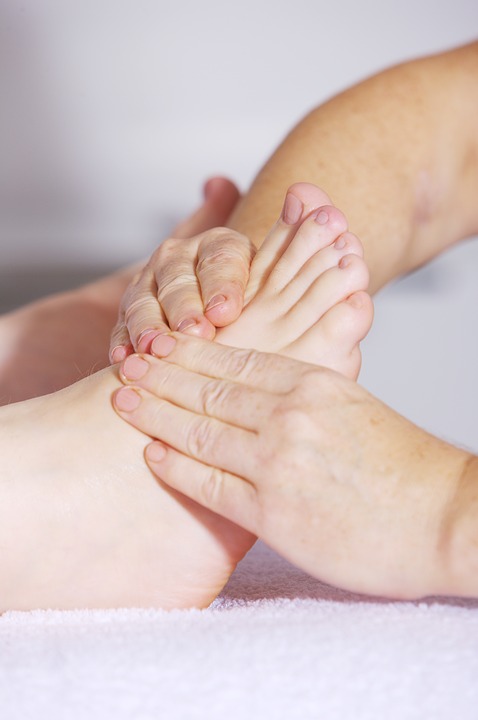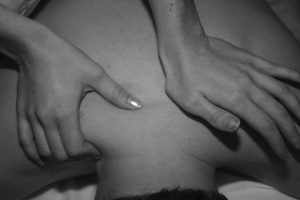
Massage is one of the best well known and most used recovery modality for athletes. There are a lot of claims about the benefits of massage, ranging from reducing muscle soreness to promoting blood flow and improving recovery of strength. But are those claims valid?
In this article I try to answer the following questions:
- Will massage reduce delayed onset muscle soreness?
- Does it affect strength recovery?
- Does it promote blood flow?
Will massage reduce delayed onset muscle soreness?
Yes, there is a ton of research confirming the claim that massage will reduce muscle soreness [2,3,4,5,6,7,8,9,10,11,12,13,15,16,17,18,19,20,21]. Researchers say there are two mechanisms involved: the gate control [29] and the release of hormones [27,28,29].
there is a ton of research confirming the claim that massage will reduce muscle soreness
Gate control.
This theory by Melzack and Wall explains how the nerves that sense ‘push/pull’ sensations in the skin and muscles can attenuate pain. Simply put: all the sensations in the body are transferred to the spinal cord, but only a selection of those sensations is sent to the brain to be detected. So all the nerve impulses come together in the spinal cord, no wonder that spinal cord injuries affect pain, movement and touch.
So there’s a form of hierarchy for the distribution of impulses, the fast fibers (called a-delta) have priority to the slow fibers (c-fibers). This is where the effect of massage comes in, massage stimulates ‘push/pull’ fibers which are fast (a-delta) and thereby overruling the pain fibers which are slow (c-fibers).
So the brain senses the massage and forgets about the pain. This works with light massages giving of lots of sensory input, this theory does not work with heavy painful massages.

Release of hormones.
The pain modulating effect of painful massages is done by the release of specific hormones. Researchers found a spike in endorphin during connective tissue massage (28), this type of massage is known to by quite painful. Endorphin is a natural opiod produced by the body and is best well known for producing the ‘runners high’. The body produces endorphin during times of great physical stress (like running a marathon) thereby lowering pain to help you keep going, it acts similar as morphine.
Besides Endorphin there are lots of other hormones produced after treatment like oxytocin and serotonin which have an effect on mood among other things.
Does it affect strength recovery?
Testing muscle power is a method researchers use to say something about recovery. By testing the power before a muscle damaging workout they establish a baseline from which they can say something about strength loss and eventually the time to full recovery. The participants are tested before the training and often 24, 48 and 72 hours afterwards.
This makes it a valuable method especially because it is a lot more objective than asking about muscle soreness.

Unfortunately massage does not affect strength recovery [6,8,9,14,20,21], although it does seem to attenuate muscle damage [4,5,7,8].
Unfortunately massage does not affect strength recovery [6,8,9,14,20,21], although it does seem to attenuate muscle damage [4,5,7,8]. Researchers use blood samples to measure Creatine Kinase (CK) levels, CK sits inside muscle fibers and when damage occurs is ends up in the blood stream making it a valuable tool to measure muscle damage.
The reason why massage attenuates muscle damage might be due to the ability to reduce inflammation. There are studies [1,7,26] that show that after a massage the concentration of pro-inflammatory cells lowers and the concentration of anti-inflammatory cells increases. Thereby lowering the inflammatory response. Inflammation is known to be responsible for ‘secondary damage’ to the muscle fibers. By lowering inflammation you can lower damage. Read more about it HERE.
Does it promote blood flow?
This is one of the most heard claims: massage promotes blood flow in the muscles.
Unfortunately not true, the amount of blood in the muscles is controlled by small muscle bands (precapillary sphincters) around the arteries. When they are relaxed the gate is open, but when they contract they act like a ty-rap and limit blood flow. These ty-raps are controlled by certain factors like temperature, hormones (like adrenaline) and metabolic factors (like pH levels) [30]. Unfortunately they are not controlled by mechanical stimuli like massage [30].
This is backed by lots of studies [20,22,23,24], they all show that the blood flow inside the muscles is not affected by massage. The red color you see after a treatment is only the increased blood flow in the skin (due to certain natural chemicals and increased temperature), but does not occur inside the muscles itself.
It’s therefore not very effective for the removal of metabolic waste products (like lactate acid), the most effective way to promote lactate acid removal is Active recovery (read more HERE).
Concluding.
Massage is a good way to reduce muscle soreness and might even attenuate muscle damage. This could be due to its ability to limit inflammation. Unfortunately, the treatment does not improve strength recovery or promote blood flow inside the muscles.
Recommended for athletes? Yes, besides the above-mentioned benefits do athletes report lower stress levels and a better mood after treatment.
Massage references
- Massage therapy attenuates inflammatory signaling after exercise-induced muscle damage
- Effect of massage on DOMS in ultramarathon runners: A pilot study
- DOMS After Acute Strenuous Exercise and Massage
- Effect of myofascia massage on reduction of blood biomarkers and recovery of delayed onset muscle soreness (DOMS) of lower body
- ( Effects of massage and microwave diathermy therapy on eccentric exercise-induced DOMS and indices of muscle damage)
- The effects of massage on delayed onset muscle soreness
- The Effects of Athletic Massage on Delayed Onset Muscle Soreness, Creatine Kinase, and Neutrophil Count: A Preliminary Report
- Effects of Massage on Delayed-Onset Muscle Soreness, Swelling, and Recovery of Muscle Function
- The effects of therapeutic massage on delayed onset muscle soreness and muscle function following downhill walking
- The effects of massage on delayed onset muscle soreness and physical performance in female collegiate athletes
- Effects of massage on delayed-onset muscle soreness
- Effects of therapeutic massage on gait and pain after delayed onset muscle soreness
- Massage effects on delayed onset muscle soreness after acute eccentric exercise
- effect of acute massage on delayed-onset muscle soreness
- Are The Effects of Deep Tissue Sports Massage on Delayed Onset Muscle Soreness Present in University Athletes
- EFFECTS OF MASSAGE VS ACTIVE EXERCISE ON EXPERIMENTALLY INDUCED DELAYED ONSET OF MUSCLE SORENESS
- The effect of massage on creatine kinase and delayed onset muscle soreness in female distance runners
- Effects of massage on symptoms and markers associated with delayed onset muscle soreness
- COMPARISON OF EFFECTS BETWEEN STATIC STRETCHING AND PETRISSAGE MASSAGE ON FUNCTIONAL-SIGNS OF DELAYED ONSET OF MUSCLE SORENESS OF KNEE EXTENSORS FOLLOWING STIMULATED PLYOMETRIC EXERCISE IN THAI MALE
- Effleurage Massage, Muscle Blood Flow and Long-Term Post-Exercise Strength Recovery
- Effects of sports massage and intermittent cold-water immersion on recovery from matches by basketball players
- Failure of manual massage to alter limb blood flow: measures by Doppler ultrasound.
- Effects of Massage on Limb and Skin Blood Flow after Quadriceps Exercise
- Massage Impairs Postexercise Muscle Blood Flow and "Lactic Acid" Removal
- The effects of massage on perceived physical soreness, pain and markers of inflammation following high intensity unaccustomed exercise
- Effects of Swedish Massage Therapy on Blood Pressure, Heart Rate, and Inflammatory Markers in Hypertensive Women
- Massage Increases Oxytocin and Reduces Adrenocorticotropin Hormone in Humans
- Increase of plasma beta-endorphins in connective tissue massage.
- The Role of Descending Modulation in Manual Therapy and Its Analgesic Implications: A Narrative Review
- Microcirculation in skeletal muscle
